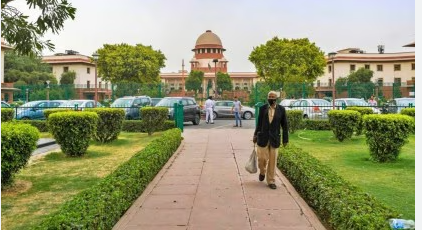Haldwani Eviction Case Supreme Court of India’s involvement in the Haldwani eviction case has drawn attention to the delicate balance between infrastructural development and the fundamental rights of citizens. On Wednesday, the court gave the Uttarakhand government two months to finalize a rehabilitation scheme for thousands of families facing eviction due to illegal occupation of railway land. This ruling underscores the importance of fairness and equity in dealing with large-scale evictions, especially when they involve a sizable population’s fundamental right to shelter.
The situation in Haldwani, Uttarakhand—a region considered the gateway to the scenic hills of the state—presents a classic case of the challenges faced when urban development clashes with human habitation, Haldwani Eviction Case when the latter is deemed illegal by authorities. In this article, we explore the legal, social, and infrastructural dimensions of the case and delve into the concept of ‘fair and equitable’ rehabilitation as mandated by the Supreme Court.
The Haldwani Eviction Case: A Background
The Haldwani eviction case revolves around the alleged illegal occupation of railway land by nearly 50,000 people in the region. The area in question includes about 4,365 houses sprawled across approximately 30 hectares of land, which the Railways urgently needs to expand its infrastructure. The Railways argued that the flooding Ghaula river had disrupted operations, necessitating immediate land acquisition to lay new tracks.
The controversy first came to a head in early 2023, when the Uttarakhand High Court ordered the eviction of these families, directing that even paramilitary forces be used if necessary. The Supreme Court, however, Haldwani Eviction Case stayed the High Court’s eviction order in January 2023, thereby offering a temporary reprieve to the families.
The Railways Haldwani Eviction Case, in subsequent hearings, filed applications to modify the Supreme Court’s stay order, arguing that infrastructural development in the region was being hindered by the encroachment. This ongoing battle between the Railways and the local population—most of whom have lived on the land for decades—reflects a larger nationwide issue where infrastructure projects and human settlements often collide.
The Supreme Court’s Directive: A ‘Fair and Equitable’ Rehabilitation
The core issue that the Supreme Court focused on during its recent hearing is how to strike a balance between the need for development and the fundamental rights of the people involved. A Bench led by Justice Surya Kant emphasized the necessity of crafting a ‘fair and equitable’ rehabilitation scheme for the displaced families, acknowledging both the importance of railway infrastructure and the constitutional right to shelter.
This decision was based on the premise that while the Railways need land to expand their operations,Haldwani Eviction Case the eviction of nearly 4,500 families cannot proceed without providing an adequate and humane alternative. Justice Kant’s directive for a “fair and equitable” rehabilitation plan underscores the necessity of finding a solution that addresses both developmental needs and human rights.
 For the more information click on this link
For the more information click on this link
Challenges of Rehabilitation
The concept of rehabilitation in large-scale eviction cases presents a myriad of challenges—legal, logistical, and financial. It involves identifying the affected families, providing them with alternative accommodation, Haldwani Eviction Case and ensuring that the transition does not result in undue hardship. In the case of Haldwani, several factors complicate the process:
1. Identifying Affected Families
One of the first tasks for the Uttarakhand government, as indicated by senior advocate Balbir Singh, is to identify the families who will be directly impacted by the eviction. A joint team comprising officials from the Railway authorities and the Ministry of Urban Affairs is expected to conduct a survey to pinpoint the number of families involved. With estimates of over 50,000 people potentially affected, determining the actual number of legitimate residents is crucial.
This process will likely involve sifting through decades of records, as many families have claimed to have lived in the region for several generations. Determining the legality of their occupation, whether through land titles or other forms of proof, will be one of the biggest hurdles. The challenge is even greater in cases where families have resided on the land for decades without any formal documentation.
2. Land Allocation for Relocation
Once the affected families have been identified, the next major challenge is finding appropriate land for relocation. Advocate Balbir Singh noted that the government is working to zero in on the land for resettlement, Haldwani Eviction Case but the process is far from straightforward. Uttarakhand, a state known for its mountainous terrain, faces geographic limitations in finding suitable land for relocation. Furthermore, the relocation must meet the needs of the families in terms of access to basic amenities like schools, healthcare, and employment opportunities.
The process of identifying and acquiring new land will also involve negotiations between the state and various authorities, including the Railways and local municipalities. Given the scale of displacement, Haldwani Eviction Case the government must ensure that the new settlements are adequately equipped to handle the influx of families, and that they do not face long-term economic or social disruption as a result of their relocation.  For the more information click on this link
For the more information click on this link
3. Financial Arrangements
The financial burden of rehabilitating nearly 50,000 people is immense. The state government must work in coordination with the Railways and the central government to finalize the financial arrangements for resettlement. This includes not only the cost of acquiring new land and constructing housing but also the provision of essential services such as water, electricity, and sanitation.
Additionally, families may require temporary housing arrangements while the new settlements are being built, which adds another layer of financial complexity. The government will also have to consider the economic implications of displacing people who rely on informal or small-scale livelihoods within the vicinity of the disputed land.
The Broader Implications of the Haldwani Eviction Case
The Haldwani eviction case is not an isolated incident. Across India, there have been numerous instances where large-scale infrastructural projects—be they railway lines, highways, or urban development—have clashed with local populations. In many cases, the people affected by such projects are marginalized communities who lack formal land titles or other legal documents proving ownership.
The Supreme Court’s directive in this case sets an important precedent for how such disputes should be handled. It highlights the need for a balanced approach that respects the rights of people, while also recognizing the importance of development for the nation’s economy.
1. Right to Shelter vs. Development
One of the core legal questions in this case is the balance between the fundamental right to shelter and the state’s duty to promote infrastructure development. The Constitution of India guarantees the right to shelter as part of the broader right to life under Article 21. This right has been interpreted to include not just physical shelter but also access to a life of dignity, which involves basic amenities such as water, Haldwani Eviction Case electricity, and sanitation.
At the same time, the state has a responsibility to develop infrastructure that benefits the public at large. Railways are a lifeline for the Indian economy, and expanding railway infrastructure is essential for improving connectivity, particularly in hilly and remote regions like Uttarakhand. The challenge lies in finding a way to harmonize these two competing interests.
2. Legal Complexities of Land Ownership
Land disputes in India often involve complex legal issues, particularly in cases where ownership records are incomplete or disputed. Many of the families living on the railway land in Haldwani claim to have resided there for generations, and it is unclear whether they have formal titles to the land. Even when residents do possess some form of documentation, proving ownership can be difficult due to the convoluted land records system in the country.
The courts will need to carefully examine the claims of both the Railways and the residents to determine the legality of the occupation. In cases where families have been living on the land for decades, even without formal titles, the principle of adverse possession may come into play, Haldwani Eviction Case whereby long-term occupation can grant a person ownership rights.
Conclusion: Toward a Fair and Just Resolution
The Supreme Court’s intervention in the Haldwani eviction case is a reminder of the judiciary’s critical role in safeguarding fundamental rights while also facilitating the development of public infrastructure. By mandating a ‘fair and equitable’ rehabilitation scheme, Haldwani Eviction Case the court has recognized that large-scale evictions, particularly of vulnerable populations, must be handled with care, compassion, and legal rigor.
As the Uttarakhand government works to finalize a rehabilitation plan over the next two months, it will need to balance competing interests—the need for railway expansion and the right to shelter of nearly 50,000 people. The outcome of this case will set an important precedent for future cases where infrastructure projects collide with human settlements, and will test the state’s ability to craft a solution that is truly ‘fair and equitable’ for all involv ALSO READ:- UNShimla Mosque Dispute: Clashes Erupt as Protesters Break Barricades and Confront Police 2024




